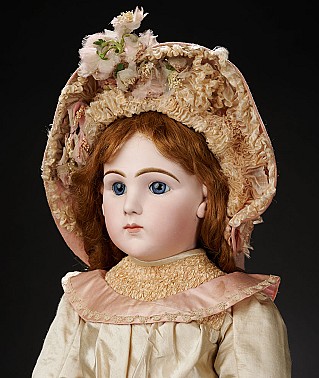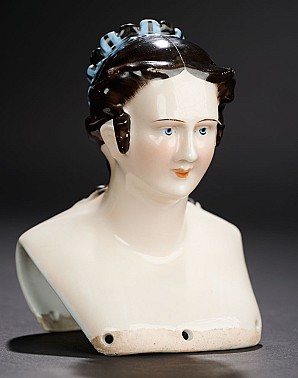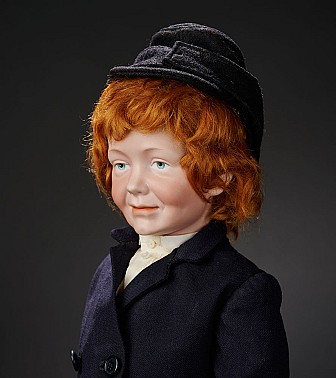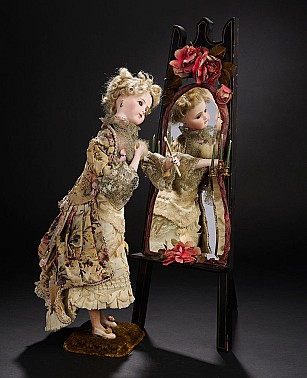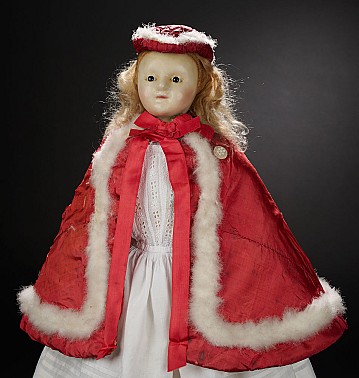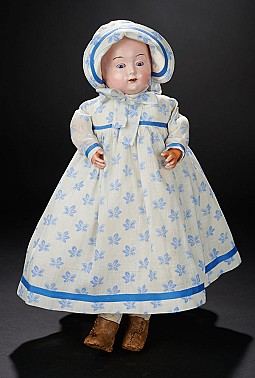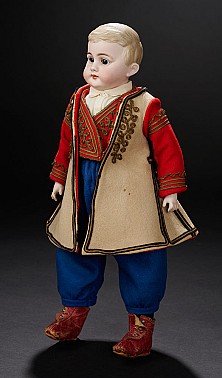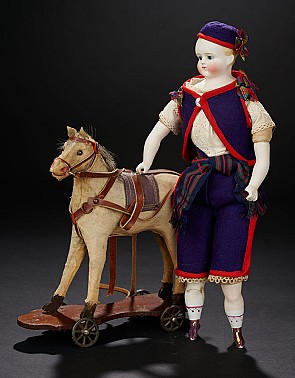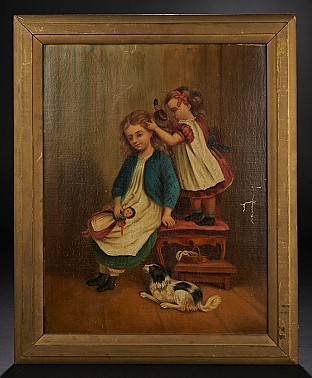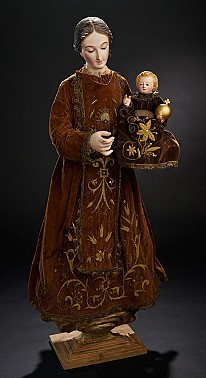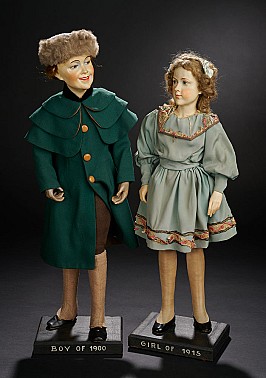The Extraordinary French Bisque Bebe "Blondine" with Trousseau and Family Provenance
Lot #17
22" (56 cm.) Bisque head with solid dome, blue glass paperweight inset eyes, dark eyeliner, painted lashes, brushstroked and feathered brows, rose blushed eye shadow, accented eye corners and nostrils, slightly parted lips with delicate accent lines, row of tiny porcelain teeth, pierced ears, original blonde lambswool wig, carton torso with clockwork mechanism, composition arms, hinged hips with kid cover, composition lower legs, key-wind mechanism in torso that causes doll to cry mama and wave arms and legs. Condition: generally excellent. Comments: doll by Jules Steiner, circa 1885. Value Points: in pristine unplayed with condition, as though never removed from her original box that is labeled in pencil script "Blondine", the remarkable bebe owns an extraordinary trousseau, some stored in a fine ebony black trunk with leather straps and brass hardware, and other clothing stored in original boxes. The clothing, which is as crisp and pristine as the day it was made, comprises silk velvet winter coat with white boa trim and with matching bonnet with seed pearl clusters and tiny feathers trimmed with gold beads, maroon stockings and black velvet shoes with silver buckles (being worn by Blondine); 11 additional chapeaux of extraordinary fabrics and detail; two fine lace bonnets, four knit caps, twelve pairs of stockings, five bibs or shawls, eight night sacs or blouses, five pantalets, six petticoats, eight chemises (seven embroidered "B"), blue woolen baby dress, elaborate Christening gown, blue tricot dress with matching hood and slippers, and four pairs of additional shoes (three pairs are signed B.V. for Brasseur-Videlier, the prestigious Parisian boutique). Accessories include two curved hair combs, bone-handled parasol in original box from A La Tentation Parisian doll boutique, jewelry, bone rattle, two boxes from Bapteme de ma Poupee. Provenance: Blondine and her trousseau originated from the French estate of the Convert Family of Oyonnax in the Jura Mountains. Beginning about 1860 the Convert name became important in the production of beautiful hair combs from the newly invented material of celluloid. Although wooden decorative combs had been produced in the town for more than a century from the plentiful nearby forest woods, this new material allowed a level of abundance that had not existed before. The Convert family thrived and enjoyed the fruits of their prosperity for themselves and for their daughter. Meanwhile, introduced in Paris at the time was the new doll phenomenon known as "bebe". Its originator was Jules Steiner to whom the Converts felt an affinity as he had been born in Dijon, not very far from their own home town. So, on a far-away trip to Paris, some 500 kms from Oyonnax, the Convert family chose a Bebe Steiner as a gift for their daughter and on subsequent trips to prestigious Parisian doll shops they added a trousseau for the doll that was notable in the luxury of its fabrics and couturier design. The doll was named Blondine, its still-faint name handwritten on the box in which has been stored for more than 135 years. The name of the daughter is not known nor is the reason why the doll and its trousseau remained unplayed with, still preserved today in unimaginably pristine condition. The doll, from its original French estate was acquired by Rosalie from a 2004 Theriault's auction, and has remained a prize of her Museum and collection for two decades.



